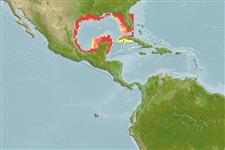Teleostei (teleosts) >
Eupercaria/misc (Various families in series Eupercaria) >
Sciaenidae (Drums or croakers)
Etymology: Cynoscion: Greek, kyon = dog + Greek, odous = teeth + Greek, skion, skiaina = barbel, red mullet (Ref. 45335).
More on author: Ginsburg.
Environment: milieu / climate zone / depth range / distribution range
Ecology
Marine; brackish; demersal. Subtropical; 30°N - 18°N, 98°W - 80°W
Western Atlantic: Florida, USA and Gulf of Mexico to Bay of Campeche, Mexico.
Length at first maturity / Size / Weight / Age
Maturity: Lm 14.0 range ? - ? cm
Max length : 63.5 cm TL male/unsexed; (Ref. 40637); common length : 35.0 cm TL male/unsexed; (Ref. 3702); max. published weight: 2.8 kg (Ref. 40637); max. reported age: 5 years (Ref. 58079)
Dorsal spines (total): 9 - 11; Dorsal soft rays (total): 25 - 29; Anal spines: 2; Anal soft rays: 10 - 12. Colour uniform silvery grey above, without conspicuous spots, silvery below. Pelvic and anal fins pale to yellowish. A faint dark area at bases and axial of pectoral fins. Inside opercle darkish, often visible externally. Mouth large, oblique, lower jaw slightly projecting. Upper jaw with a pair of large canine-like teeth at tip. Lower jaw with a row of widely spaced larger inner-row teeth, gradually increasing in size posteriorly. Chin without barbel or pore, snout with 2 marginal pores. Gas bladder with a pair of horn-like anterior appendages. Soft portion of dorsal fin with few small scales rows at base between soft fin rays (Ref 51721).
Occurs usually over sandy bottoms in shallow coastal waters, being relatively abundant in the surf zone. During summer months the fish move to their nursery and feeding grounds in river estuaries.
Life cycle and mating behavior
Maturities | Reproduction | Spawnings | Egg(s) | Fecundities | Larvae
Robins, C.R. and G.C. Ray, 1986. A field guide to Atlantic coast fishes of North America. Houghton Mifflin Company, Boston, U.S.A. 354 p. (Ref. 7251)
IUCN Red List Status (Ref. 130435)
Threat to humans
Harmless
Human uses
Fisheries: commercial
Tools
Special reports
Download XML
Internet sources
Estimates based on models
Preferred temperature (Ref.
123201): 23.4 - 27.1, mean 24.8 °C (based on 190 cells).
Phylogenetic diversity index (Ref.
82804): PD
50 = 0.5000 [Uniqueness, from 0.5 = low to 2.0 = high].
Bayesian length-weight: a=0.01023 (0.00609 - 0.01719), b=3.06 (2.92 - 3.20), in cm total length, based on LWR estimates for this species & Genus-body shape (Ref.
93245).
Trophic level (Ref.
69278): 4.2 ±0.3 se; based on diet studies.
Generation time: 3.5 ( na - na) years. Estimated as median ln(3)/K based on 1
growth studies.
Resilience (Ref.
120179): Medium, minimum population doubling time 1.4 - 4.4 years (Preliminary K or Fecundity.).
Fishing Vulnerability (Ref.
59153): Moderate vulnerability (36 of 100).
Nutrients (Ref.
124155): Calcium = 65.5 [35.9, 126.6] mg/100g; Iron = 1.01 [0.53, 1.76] mg/100g; Protein = 19.1 [17.6, 20.8] %; Omega3 = 0.372 [0.217, 0.586] g/100g; Selenium = 26.9 [14.2, 52.0] μg/100g; VitaminA = 16 [5, 55] μg/100g; Zinc = 0.64 [0.46, 0.93] mg/100g (wet weight); based on
nutrient studies.
